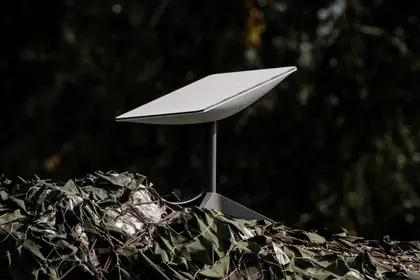In January, Starlink announced a “Direct to Cell” technology that would enable long-term evolution (LTE) satellite connection accessible from smartphones as early as 2025, with a wide coverage no competitors come close to matching at the time of writing.
At present, the use of Starlink devices remains prevalent in Ukraine and requires a dedicated device, but the new technology could soon eliminate that.
JOIN US ON TELEGRAM
Follow our coverage of the war on the @Kyivpost_official.
However, past decisions by Elon Musk, Starlink’s owner, have raised concerns over the implications of the technology’s development and usage.
What is Starlink?
Starlink is a satellite telecommunications service under SpaceX, a US aerospace company owned by multibillionaire Elon Musk.
With Starlink (or similar satellite communications services), internet data is beamed through radio waves between the user terminal (similar to a satellite dish), ground stations on Earth, and orbiting satellites, providing users with internet coverage even in places with no network towers.
As of this month, there are 5,442 operational Starlink satellites in orbit; their low altitude of around 550 kilometers also helps reduce signal latency.
The company’s vertical integration – namely its ability to produce, launch and operate satellites – also sets it apart from its competitors.
What Are the Changes?
In short, the new technology – through newer satellites – will operate as “cell towers in space” and provide satellite connectivity through partnerships with telecom operators such as T-Mobile in the US – “similar to a roaming partner,” in Starlink’s own words.

Elon Musk Took Part in Trump-Zelensky Call: Ukrainian Official
According to the company, text services are already available, while voice and internet connection will likely be available next year.
The first difference compared to existing satellites is stronger radio signal emission to compensate for the low-power antennas used by mobile devices.
“Our team developed custom silicon onboard the satellite that is optimized for this application and reduces power and cost on the satellite. We also developed large 2.7m x 2.3m advanced phased arrays that use extremely sensitive radio receivers and high-powered transmitters for communicating with cell phones from space,” according to the company’s update.
Another challenge the company overcame was the physical positioning and orientation of the satellites.
“For the vehicles to perform like a true cell tower in space, handoffs between vehicles and on the ground must be completely seamless to the user.
“To accomplish this, we architected the system including satellite altitudes, beam size and placement, elevation angles, and a number of satellites, such that we are just at the edge of physics where LTE is achievable and reliable,” the update said.
The Extent of Musk’s Influence
Past statements from SpaceX owner Elon Musk have cast doubt on the technology’s real-world applications.
At the onset of Russia’s full-scale invasion, Musk provided Ukraine with a few thousand Starlink devices, which gave the Ukrainian military the necessary means to maintain communication, which helped deter the Russian invasion. The Pentagon recognized the need and helped procure more Starlink terminals for Kyiv.
All was well until Ukrainian forces reported occasional service disruptions, which led to speculation about Musk’s involvement, considering his frequent repetition of pro-Russian propaganda narratives.
In September 2023, it also came to light that Musk had personally refused Kyiv’s request to turn on the Starlink connection near occupied Crimea a year prior – which had been disabled by default since the area was under Russian control and sanctions – in what he said was a fear of escalation.
“If I had agreed to their request, then SpaceX would be explicitly complicit in a major act of war and conflict escalation,” Musk wrote.
There was an emergency request from government authorities to activate Starlink all the way to Sevastopol.
— Elon Musk (@elonmusk) September 7, 2023
The obvious intent being to sink most of the Russian fleet at anchor.
If I had agreed to their request, then SpaceX would be explicitly complicit in a major act of war and…
While the legitimacy of his decision remains a subject of debate, later Ukrainian operations of a similar nature have demonstrated Musk’s alleged concerns to be largely unfounded.
Nonetheless, concerns over Musk’s ability to influence the state of affairs due to his monopoly over major technology and his personal political stance remained.
“There was little precedent for a civilian becoming the arbiter of a war between nations while the government has no level of control over his decisions,” remarked US journalist Ronan Farrow.
According to Swiss media outlet NZZ, Musk owns 42 percent of all SpaceX shares but controls 79 percent of the voting rights, meaning he has de facto control over how and where the technology will be deployed – and shut down if needed.
Where does that lead us?
At present, most telecom operators must adhere to local government regulations. In democratic nations it is generally assumed that encroachment on free information flow and access is not without consequences. People can decide on alternatives – and have done so the past – be it the government or telecom operators.
But when the control of said technology, as in the case of Musk’s Starlink services, remain in the hands of a single person, the situation becomes complicated.
The long-term effect of Starlink’s technology – and potential monopoly – on global communications remains to be seen, but Musk’s previous actions argue a strong case for caution.
You can also highlight the text and press Ctrl + Enter






